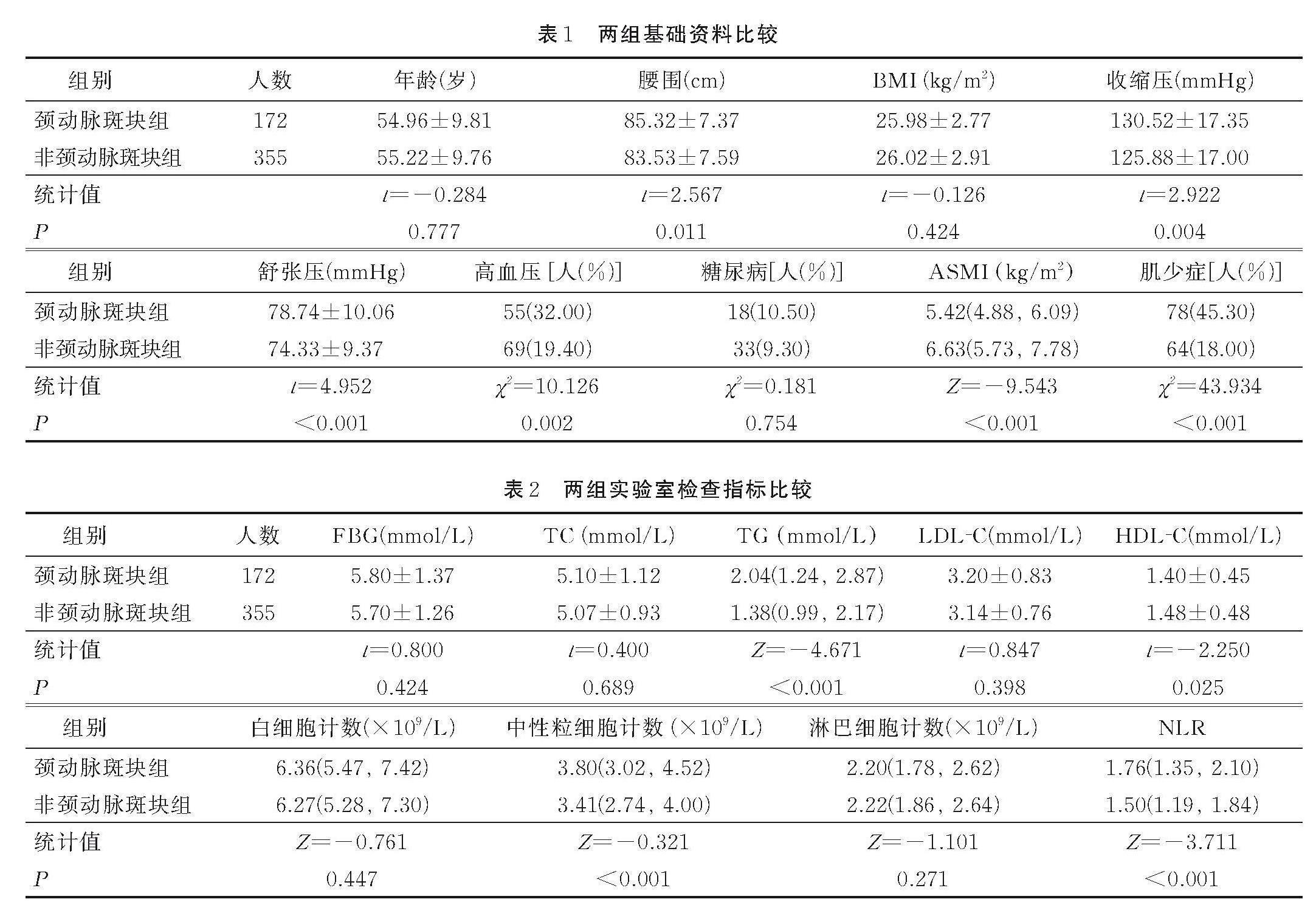绝经后女性肌少症与颈动脉斑块发生风险的关系
2024-07-10戈凌霞冯健吴良玉刘琴朱小贤夏青
戈凌霞 冯健 吴良玉 刘琴 朱小贤 夏青



基金项目 上海市加强公共卫生体系建设三年行动计划(2023-2025年)项目,编号:GWVI?11.1?28
作者简介 戈凌霞,主管护师,本科
通讯作者 夏青,E?mail:1034441245@qq.com
引用信息 戈凌霞,冯健,吴良玉,等.绝经后女性肌少症与颈动脉斑块发生风险的关系[J].护理研究,2024,38(13):2276?2280.
Relationship between sarcopenia and carotid plaque risk in post?menopausal women
GE Lingxia, FENG Jian, WU Liangyu, LIU Qin, ZHU Xiaoxian, XIA Qing
Health Examination Center of Shanghai Health and Medical Center(Huadong Sanatorium), Jiangsu 214065 China
Corresponding Author XIA Qing, E?mail: 1034441245@qq.com
Abstract Objective:To investigate the relationship between sarcopenia and the risk of carotid plaque in postmenopausal women.Methods:A total of 527 postmenopausal women who underwent physical examination in the health examination center of Huadong Sanatorium from March to October 2022 were selected as the research objects by random cluster sampling.The body composition analyzer (InBody720) was used to calculate the skeletal muscle mass of human limbs, appendicular skeletal muscle index (ASMI) was calculated and handgrip and walking speed were measured. Clinical data were collected, univariate combined with multivariate regression analysis was used to explore the relationship between sarcopenia and the risk of carotid plaque in postmenopausal women,and receiver operating characteristic (ROC) curve was used to explore the diagnostic value of ASMI in the occurrence of carotid plaque in postmenopausal women.Results:Among 527 postmenopausal women, 172 (32.6%) had carotid plaque. In postmenopausal women, ASMI in the carotid plaque group was significantly lower than that in the non-carotid plate group [5.42(4.88,6.09)kg/m2 vs 6.63(5.73,7.78)kg/m2,P<0.001]. The incidence of sarcopenia in the carotid plaque group was significantly higher than that in the non-carotid plaque group (45.3% vs 18.0%, P<0.001).The lower the ASMI value in postmenopausal women,the higher the risk of carotid plaque (Pfor trend<0.001).Multivariate logistic regression analysis showed that postmenopausal women with sarcopenia significantly increased the risk of carotid plaque(OR=3.486,95%CI 2.237-5.432). ROC showed that ASMI had a higher predictive value for carotid plaque than waist circumference and body mass index (AUC=0.756).Conclusions:Sarcopenia significantly increases the risk of carotid artery plaque in postmenopausal women,and ASMI can be used as a simple predictor of carotid artery plaque.
Keywords postmenopausal; carotid artery plaque; sarcopenia; appendicular skeletal muscle index, ASMI; influencing factors;prediction
摘要 目的:探讨绝经后女性肌少症与颈动脉斑块发生风险的相关性。方法:采用整群抽样法,选取2022年3月—10月在华东疗养院体检中心进行健康体检的绝经后女性527例为研究对象。采用人体成分分析仪(InBody720)检测人体四肢骨骼肌质量,计算四肢骨骼肌指数(ASMI)并测量握力与步速。收集一般资料及实验室指标,采用多因素Logistic回归分析探讨绝经后女性肌少症与颈动脉斑块发生风险的关系,并采用受试者工作特征(ROC)曲线探讨ASMI对颈动脉斑块发生的预测价值。结果:527例绝经后女性中,172例发生颈动脉斑块,发生率为32.6%。绝经后女性颈动脉斑块组ASMI低于非颈动脉斑块组[5.42(4.88,6.09)kg/m2与 6.63(5.73,7.78)kg/m2,P<0.001],同时颈动脉斑块组肌少症发生率显著高于非颈动脉斑块组(45.30%与18.00%,P<0.001)。绝经后女性ASMI越小,颈动脉斑块发生风险越高(Pfor trend<0.001)。多因素Logistic回归分析显示,肌少症增加绝经后女性颈动脉斑块发生风险[OR=3.486,95%CI(2.237,5.432)]。ROC分析显示,相比于腰围及体质指数,ASMI对颈动脉斑块有更高的预测价值(ROC曲线下面积=0.756)。结论:绝经后女性肌少症增加其颈动脉斑块发生风险,ASMI可作为预测其颈动脉斑块发生的简易指标。
关键词 绝经后女性;颈动脉斑块;肌少症;四肢骨骼肌指数;影响因素;预测
doi:10.12102/j.issn.1009-6493.2024.13.004
亚洲肌少症工作组在2020年发布的《肌少症诊断、治疗2019更新版共识》中指出,肌少症是与增龄有关的进行性全身肌肉减少和/或肌肉强度下降或肌肉生理功能减退的症状[1]。肌少症涉及多种风险因素及机制,包括遗传、营养、运动、神经功能、肌细胞凋亡及机体激素变化情况[2]。而肌少症在绝经后女性群体中发生率较高,据统计,有31%的绝经后女性出现肌少症[3],由于雌激素水平显著下降会导致代谢功能紊乱,同时影响骨骼肌的肌蛋白合成[4]。同时有研究显示,绝经后女性颈动脉粥样硬化或斑块形成的发生同样显著增高,可能与雌激素缺乏导致血管保护发生紊乱有关[5?6]。而肌少症与机体代谢异常也密切相关,既往有研究证实肌少症会增加糖尿病人群颈动脉粥样硬化发生风险[7],而目前尚未检索到相关研究证实肌少症会增加绝经后女性人群颈动脉斑块的发生风险,绝经后女性随着脂肪质量和分布发生改变,其肥胖指标如体重指数和腰围也会发生相应变化,同时过度肥胖会显著增加颈动脉斑块的发生风险,也未检索到肌少症与肥胖指标对绝经后女性发生颈动脉斑块预测价值的比较相关研究。因此,本研究拟探讨绝经后女性肌少症与颈动脉斑块发生风险的相关性,旨在对绝经后女性早期进行肌少症干预、预防颈动脉斑块发生提供参考。
1 对象与方法
1.1 研究对象
采用整群抽样法,选取2022年3月—10月在华东疗养院体检中心进行常规健康体检的绝经后女性527人,年龄40~88(55.13±9.77)岁。排除标准:严重肝、肾功能不全;手术或意外因素导致突然停经;无法独立完成调查;患有骨关节疾病(腰椎间盘突出、类风湿关节炎)或骨骼肌损伤;基本健康体检信息不全。本研究取得病人知情同意,并经华东疗养院伦理委员会审核通过。
1.2 资料收集
1.2.1 基线资料
基础资料包括年龄、腰围(WC)、体重指数(BMI)、收缩压、舒张压[8]。
1.2.2 实验室检查指标
采集体检者清晨空腹静脉血10~15 mL,实验室检查包括空腹血糖(FBG)、三酰甘油(TG)、总胆固醇(TC)、低密度脂蛋白胆固醇(LDL?C)、高密度脂蛋白胆固醇(HDL?C)、白细胞计数(WBC)、中性粒细胞计数(NE)、淋巴细胞计数,并计算中性粒细胞/淋巴细胞百分比(NLR)。所有实验室指标均在采样后24 h内于华东疗养院医学检验中心进行检验。
1.3 诊断标准
1.3.1 肌少症
采用InBody720多频生物电阻抗人体成分分析仪对研究对象进行四肢骨骼肌评估,受试者禁食、禁饮8 h,排空大小便。研究对象赤足站立于电极板上,双手握住电极,分析仪自动计算四肢骨骼肌质量。四肢骨骼肌指数(ASMI)=四肢骨骼肌质量(kg)/[身高(m)]2;测量研究对象优势手握力,采用奥匹握力测试仪(AP?1005)进行握力测试,间隔30 s,连续测量3次取最大值;采用6 m行走距离测量其步速,连续测量3次取最大值。肌少症按照2016年中华医学会骨质疏松和骨矿盐疾病分会制定的肌少症相关共识诊断,将ASMI<5.7 kg/m2,女性握力≤18 kg且步速低于0.8 m/s作为肌少症诊断标准[9]。
1.3.2 颈动脉斑块
采用美国GELogiqE9超声诊断仪检测颈动脉血管情况。研究对象取仰卧位,头偏向检查侧对侧,充分暴露颈部区域,超声探头依次沿着颈总动脉端、分叉处以及颈内动脉、颈外动脉起始处的内膜中层厚度进行扫描,颈动脉内膜中层厚度≥1.5 mm诊断为颈动脉斑块形成[10]。
1.3.3 糖尿病
根据《中国肥胖及2型糖尿病外科治疗指南(2019版)》对2型糖尿病的定义,即空腹血糖(FBG)≥7.0 mmol/L或糖化血红蛋白≥6.5%即诊断为糖尿病[11]。
1.3.4 高血压
根据《中国高血压防治指南(2018年修订版)》定义,高血压指收缩压≥140 mmHg和(或)舒张压≥90 mmHg[12]。
1.4 统计学方法
采用SPSS 24.0软件进行统计分析,定量资料符合正态分布,采用均数±标准差(x±s)描述,组间比较采用t检验,非正态分布的定量资料采用中位数、四分位数[M(P25,P75)]描述,组间比较采用秩和检验;定性资料以例数、百分比(%)表示,组间比较采用χ2检验。采用趋势性检验分析ASMI不同四分位区间与颈动脉斑块发生风险的关系。采用多因素Logistic回归分析探讨绝经后女性肌少症与颈动脉斑块发生的关系。采用受试者工作特征曲线(ROC)评估ASMI、腰围及BMI对颈动脉斑块发生的预测价值。P<0.05为差异有统计学意义。
2 结果
2.1 绝经后女性颈动脉斑块发生风险影响因素的单因素分析
本研究共纳入527名绝经后女性,172人发生颈动脉斑块,发生率为32.6%。颈动脉斑块组肌少症发生率(45.30%)高于非颈动脉斑块组(18.00%),差异有统计学意义(χ2=43.934,P<0.001)。单因素分析结果见表1、表2。
2.2 绝经后女性ASMI不同数值区间与颈动脉斑块发生风险的关系
根据ASMI四分位区间划分Q1、Q2、Q3及Q4共4个区间,结果显示,调整腰围、高血压、TG、HDL?C及NLR等混杂因素后,以Q4为参照组,结果显示,Q1[OR=11.92,95%CI(5.83,24.26)]、Q2[OR=9.18,95%CI(4.47,18.83)]及Q3[OR=2.58,95%CI(1.25,5.34)]绝经后女性颈动脉斑块发生风险均增加(P<0.05),且随着ASMI数值的降低,其颈动脉斑块发生风险也显著增加(Pfor trend<0.001)。见表3。
2.3 绝经后女性颈动脉斑块发生风险影响因素的多因素Logistic回归分析
将腰围、TG、HDL?C、NLR(连续变量以实际值赋值)和高血压(否=0,是=1)、肌少症(否=0,是=1)作为自变量,以绝经后女性是否发生颈动脉斑块为因变量(否=0,是=1)进行多因素Logistic回归分析。结果显示,肌少症是绝经后女性发生颈动脉斑块的独立危险因素[OR=3.486, 95%CI(2.237,5.432)]。见表4。
2.4 ASMI、BMI及腰围对绝经后女性颈动脉斑块发生风险的预测价值
进一步比较ASMI、腰围及BMI对绝经后女性发生颈动脉斑块的预测价值,结果显示,相较于腰围及BMI,绝经后女性ASMI对颈动脉斑块发生的预测价值更高,其ROC曲线下面积(AUC)为0.756,灵敏度为83.70%,特异度为72.50%,Youden指数为0.562。见图1、表5。
3 讨论
绝经后女性由于卵巢功能衰退,其所分泌的性激素也显著下降,既往研究已经证实雌激素对心血管及骨骼肌组织生理活性具有重要作用[13?14]。女性在50岁后肌肉质量会显著下降,绝经后女性的肌肉组织以每年0.6%递减,尤其在绝经后3年内,肌肉量下降速度最快[15?17]。由于雌激素与睾酮水平随着年龄的增长逐渐下降,其在肌肉组织的代谢和合成中的作用不断降低,而研究表明绝经后女性睾酮水平降低比较缓慢,对其肌肉量影响较小[18]。因此,绝经后女性肌肉量减少主要与雌激素降低密切相关。在肌肉细胞膜、细胞质及细胞核上均有雌激素受体[19?20],通过胰岛素样生长因子?1(insulin?like growth factor 1,IGF?1)等途径影响肌肉蛋白质合成[21]。同时有研究表明,绝经后女性存在血管内皮依赖性和非依赖性舒张功能障碍,导致颈动脉内膜中层增厚及斑块的形成[22?24]。这可能与绝经后女性雌激素下降导致脂质代谢异常有关。研究表明,雌二醇可降低绝经后女性脂蛋白水平,减少脑血管栓塞的发生。除了雌激素对血脂的调节功能,还有研究显示雌激素可抑制内皮细胞黏附分子的表达,促进一氧化氮的合成,减少平滑肌细胞增殖,抑制趋化物质和单核细胞的化学吸附作用,并降低纤维蛋白原合成[5, 25]。随着绝经后雌激素的降低,雌激素对血脂调节功能下降,对血管保护作用不断降低,其颈动脉斑块发生风险也不断增高。
多因素回归分析显示,绝经后女性肌少症显著增加颈动脉斑块发生风险(OR=3.486)。由于肌少症与颈动脉粥样斑块形成具有一些共同的病理生理机制,其中包括机体慢性炎症、胰岛素抵抗及增龄等。慢性炎症产生大量炎性细胞因子及增龄导致的细胞氧化应激作用会促进血管内皮细胞功能紊乱,并加速血管粥样斑块形成[26]。而骨骼肌作为胰岛素作用的重要场所,胰岛素抵抗会导致肌肉蛋白的合成速度显著下降,并增加肌蛋白分解,造成肌肉组织大量流失[27]。同时,胰岛素抵抗会引起脂质代谢和血管内皮细胞紊乱,进一步加剧动脉粥样硬化的发生[28?29]。增龄也会促进肌肉组织减少并伴有内脏等异位脂肪堆积[30]。高龄人群脂代谢与糖代谢会进一步加剧肥胖形成,肥胖人群也成为颈动脉斑块发生的高危人群[31]。而既往研究尚未探索绝经后女性肥胖指标与肌少症预测颈动脉斑块形成的差异,而本研究显示ASMI在绝经后女性颈动脉斑块的诊断价值要优于腰围及BMI,提示肌少症人群可能比肥胖人群更容易出现颈动脉斑块。
4 小结
综上所述,绝经后女性可能由于雌激素水平下降或伴有脂代谢异常及增龄因素,导致肌少症发生率显著增加,肌少症产生的同时会显著增加其颈动脉斑块发生风险,临床应重点干预绝经后肌少症人群,降低其颈动脉斑块发生风险。
参考文献:
[1] CHEN L K,WOO J,ASSANTACHAI P,et al.Asian Working Group for Sarcopenia:2019 consensus update on sarcopenia diagnosis and treatment[J].Journal of the American Medical Directors Association,2020,21(3):300-307.
[2] 于宝海,吴文娟.2018欧洲肌少症共识解读[J].河北医科大学学报,2019,40(4):373-379;384.
YU B H,WU W J.Interpretation of 2018 European myopenia consensus[J].Journal of Hebei Medical University,2019,40(4):373-379;384.
[3] PAP Z,KALABISKA I,BALOGH ?,et al.Prevalence of sarcopenia in community dwelling outpatient postmenopausal Hungarian women[J].BMC Musculoskeletal Disorders,2022,23(1):207.
[4] KOO B K,ROH E,YANG Y S,et al.Difference between old and young adults in contribution of β-cell function and sarcopenia in developing diabetes mellitus[J].Journal of Diabetes Investigation,2016,7(2):233-240.
[5] 王彦永,张庆,王铭维.绝经与颈动脉粥样硬化发生发展的关系[J].中国全科医学,2010,13(14):1607-1608.
WANG Y Y,ZHANG Q,WANG M W.Relationship between menopause and occurrence and development of carotid atherosclerosis[J].Chinese General Practice,2010,13(14):1607-1608.
[6] VAIDYA D,GOLDEN S H,HAQ N,et al.Association of sex hormones with carotid artery distensibility in men and postmenopausal women:multi-ethnic study of atherosclerosis[J].Hypertension,2015,65(5):1020-1025.
[7] SEO D H,LEE Y H,SUH Y J,et al.Low muscle mass is associated with carotid atherosclerosis in patients with type 2 diabetes[J].Atherosclerosis,2020,305:19-25.
[8] HESLOP K,ROSS C.The alcohol smoking and substance involvement screening test in an acute mental health setting[J].Australian Nursing & Midwifery Journal,2014,21(11):47.
[9] 中华医学会骨质疏松和骨矿盐疾病分会.肌少症共识[J].中华骨质疏松和骨矿盐疾病杂志,2016,9(3):215-227.
Chinese Society of Osteoporosis and Bone Mineral Diseases.Myopenia consensus[J].Chinese Journal of Osteoporosis and Bone Mineral Research,2016,9(3):215-227.
[10] VAN DAM-NOLEN D H K,TRUIJMAN M,VAN DER KOLK A,et al.Carotid plaque characteristics predict recurrent ischemic stroke:the Plaque At Risk(PARISK) study[J].Atherosclerosis,2022,355:29.
[11] 王勇,王存川,朱晒红,等.中国肥胖及2型糖尿病外科治疗指南(2019版)[J].中国实用外科杂志,2019,39(4):301-306.
WANG Y,WANG C C,ZHU S H,et al.Guidelines for surgical treatment of obesity and type 2 diabetes in China(2019 edition)[J].Chinese Journal of Practical Surgery,2019,39(4):301-306.
[12] 中国高血压防治指南编写组,中国高血压联盟,中华医学会心血管病学分会,等.中国高血压防治指南(2018年修订版)[J].中国心血管杂志,2019,24(1):24-56.
Writing Group of Chinese Guidelines for the Management of Hypertension,Chinese Hypertension League,Chinese Society of Cardiology,et al.2018 Chinese guidelines for the management of hypertension[J].Chinese Journal of Cardiovascular Medicine,2019,24(1):24-56.
[13] KNOWLTON A A,LEE A R.Estrogen and the cardiovascular system[J].Pharmacology & Therapeutics,2012,135(1):54-70.
[14] DOS SANTOS R L,DA SILVA F B ,RIBEIRO R F J,et al.Sex hormones in the cardiovascular system[J].Hormone Molecular Biology and Clinical Investigation,2014,18(2):89-103.
[15] CHIU T H,CHEN S C,YU H C,et al.Association between geriatric nutrition risk index and skeletal muscle mass index with bone mineral density in post-menopausal women who have undergone total thyroidectomy[J].Nutrients,2020,12(6):1683.
[16] KO J,PARK Y M.Menopause and the loss of skeletal muscle mass in women[J].Iranian Journal of Public Health,2021,50(2):413-414.
[17] MALTAIS M L,DESROCHES J,DIONNE I J.Changes in muscle mass and strength after menopause[J].Journal of Musculoskeletal & Neuronal Interactions,2009,9(4):186-197.
[18] DAVISON S L,BELL R,DONATH S,et al.Androgen levels in adult females:changes with age,menopause,and oophorectomy[J].The Journal of Clinical Endocrinology & Metabolism,2005,90(7):3847-3853.
[19] STRAUB R H.The complex role of estrogens in inflammation[J].Endocrine Reviews,2007,28(5):521-574.
[20] AGOSTINI D,ZEPPA D S,LUCERTINI F,et al.Muscle and bone health in postmenopausal women:role of protein and vitamin D supplementation combined with exercise training[J].Nutrients,2018,10(8):1103.
[21] DRUMMOND M J,FRY C S,GLYNN E L,et al.Rapamycin administration in humans blocks the contraction-induced increase in skeletal muscle protein synthesis[J].The Journal of Physiology,2009,587(Pt 7):1535-1546.
[22] MOREAU K L.Modulatory influence of sex hormones on vascular aging[J].American Journal of Physiology Heart and Circulatory Physiology,2019,316(3):H522-H526.
[23] WANG C Y,ZHANG W,WANG Y Y,et al.Novel associations between sex hormones and diabetic vascular complications in men and postmenopausal women:a cross-sectional study[J].Cardiovascular Diabetology,2019,18(1):97.
[24] MILLER A A,DE SILVA T M,JACKMAN K A,et al.Effect of gender and sex hormones on vascular oxidative stress[J].Clinical and Experimental Pharmacology & Physiology,2007,34(10):1037-1043.
[25] 白瑞娜,李立志.老年女性高血压之衰老病因与病理机制[J].中西医结合心脑血管病杂志,2015,13(14):1690-1692.
BAI R N,LI L Z.Etiology and pathological mechanism of aging in elderly women with hypertension[J].Chinese Journal of Integrative Medicine on Cardio/Cerebrovascular Disease,2015,13(14):1690-1692.
[26] EL ASSAR M,ANGULO J,RODR?GUEZ-MA?AS L.Oxidative stress and vascular inflammation in aging[J].Free Radical Biology & Medicine,2013,65:380-401.
[27] CLEASBY M E,JAMIESON P M,ATHERTON P J.Insulin resistance and sarcopenia:mechanistic links between common comorbidities[J].The Journal of Endocrinology,2016,229(2):R67-R81.
[28] MORLEY J E.Hormones and sarcopenia[J].Current Pharmaceutical Design,2017,23(30):4484-4492.
[29] KAWADA T.Insulin resistance and sarcopenia are closely related to metabolic syndrome in male and female adolescents[J].Public Health Nutrition,2016,19(8):1528.
[30] KIM S H,KANG H W,JEONG J B,et al.Association of obesity,visceral adiposity,and sarcopenia with an increased risk of metabolic syndrome:a retrospective study[J].PLoS One,2021,16(8):e0256083.
[31] 夏青,戈凌霞,卢亚运,等.绝经早期女性代谢肥胖与颈动脉斑块的关联研究[J].预防医学,2021,33(10):1077-1080.
XIA Q,GE L X,LU Y Y,et al.Relationship between metabolic obesity phenotypes and carotid plaque in women at early stage of menopause[J].Preventive Medicine,2021,33(10):1077-1080.
(收稿日期:2023-06-16;修回日期:2024-04-08)
(本文编辑 崔晓芳)
